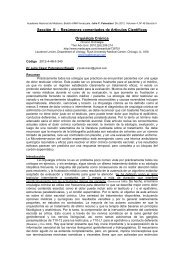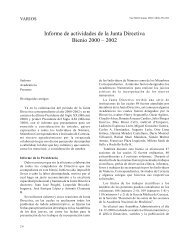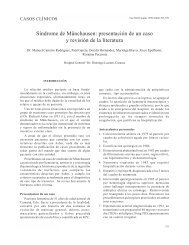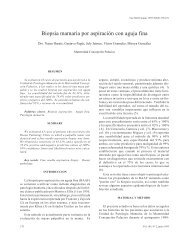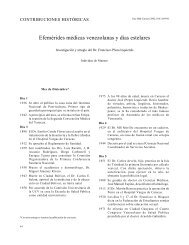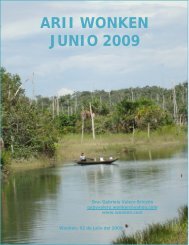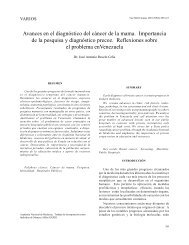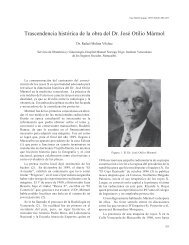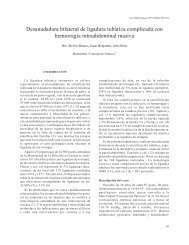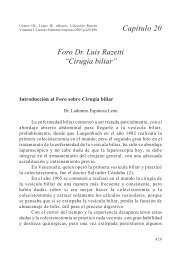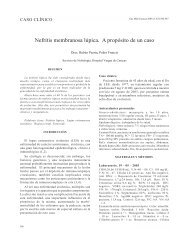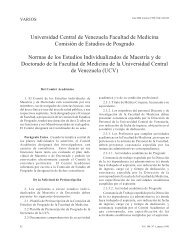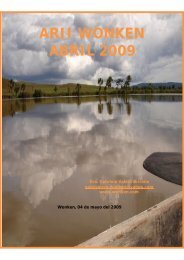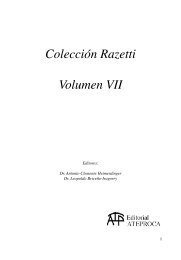La parábola de los seis ciegos y el elefante indostano o ...
La parábola de los seis ciegos y el elefante indostano o ...
La parábola de los seis ciegos y el elefante indostano o ...
You also want an ePaper? Increase the reach of your titles
YUMPU automatically turns print PDFs into web optimized ePapers that Google loves.
lo <strong>de</strong> a<strong>de</strong>ntro con lo <strong>de</strong> afuera...<br />
lo local con lo general...<br />
<strong>el</strong> micro con <strong>el</strong> macrocosmos...<br />
En nuestro rol <strong>de</strong> médicos especialistas y aún<br />
más, sub-especialistas o super-especialistas con<br />
conocimiento específico <strong>de</strong> un área, amplia o estrecha<br />
<strong>de</strong> la integridad humana, somos <strong>de</strong> hecho, hombres<br />
<strong>ciegos</strong> intentando <strong>de</strong>scribir <strong>el</strong> <strong>el</strong>efante, técnicos<br />
<strong>de</strong>shumanizados reduciendo la complejidad <strong>de</strong>l ser<br />
a un código <strong>de</strong> barras. No dudamos que este tipo <strong>de</strong><br />
convergencia científica sea necesaria y, en última<br />
instancia, una parte saludable <strong>de</strong> la investigación.<br />
Ella también, sin embargo, sugiere que para este<br />
caso particular, la ceguera es una metáfora apropiada.<br />
Ten<strong>de</strong>mos a calzar anteojeras que, mientras pue<strong>de</strong>n<br />
centrar nuestra investigación en un área reducida <strong>de</strong>l<br />
paciente o en <strong>el</strong> tópico que investigamos, también<br />
nos impi<strong>de</strong> apreciar la complejidad, la urdimbre y las<br />
repercusiones más amplias sobre <strong>el</strong> hombre como un<br />
todo que no admite fragmentaciones y <strong>los</strong> sistemas<br />
biológicos <strong>de</strong> que investigamos.<br />
Moraleja:<br />
Suce<strong>de</strong> así cada día<br />
en bastantes discusiones;<br />
quienes disputan, cada uno<br />
piensa justas sus razones.<br />
Discuten, juzgan, <strong>de</strong>finen<br />
¡lo que no vieron jamás!<br />
Figura 7. El internista, <strong>el</strong> gran integrador…<br />
MUCI-MENDOZA R<br />
REFERENCIAS<br />
1. Acuar<strong>el</strong>a <strong>de</strong> palabras: <strong>La</strong> historia <strong>de</strong> <strong>los</strong> <strong>seis</strong> <strong>ciegos</strong> y<br />
<strong>el</strong> <strong>el</strong>efante. Cuento popular <strong>de</strong> la India. Available from<br />
URL: http://acuar<strong>el</strong>a.wordpress.com/2006/08/07/lahistoria-<strong>de</strong>-<strong>los</strong>-<strong>seis</strong>-<strong>ciegos</strong>-y-<strong>el</strong>-<strong>el</strong>efante/<br />
2. Saxe JG. From Wikipedia, the free encyclopedia.<br />
Available from URL: http://en.wikipedia.org/wiki/<br />
John_Godfrey_Saxe<br />
3. Virtual American Biographies. Available from<br />
U R L : h t t p : / / w w w. f a m o u s a m e r i c a n s . n e t /<br />
johngodfreysaxe/<br />
4. Saxe JG. The blind men and the <strong>el</strong>ephant. McGraw-<br />
Hill Book Company, Inc. Nueva York. EE.UU. 1963.<br />
5. Damasio AR. Descartes error. Emotion, reason, and<br />
the human brain. GP Putman´s Book. Nueva York.<br />
1994.<br />
6. Ingle DJ. I went to see the <strong>el</strong>ephant. NuevaYork:<br />
Vantage Press, 1963.<br />
7. Groopman J, Hartzband P. Seing the whole picture.<br />
ACP Hospitalist. April 2010:28-29.<br />
8. Migliori GB, Richardson MD, <strong>La</strong>nge C. Of blind men<br />
and <strong>el</strong>ephants: Making sense of extensiv<strong>el</strong>y drugresistant<br />
tubercu<strong>los</strong>is. Amer J Resp Crit Care Med.<br />
2008;178:1000-1001.<br />
9. Varki A. Six blind men and the <strong>el</strong>ephant—the many<br />
faces of heparan sulfate. Proc Natl Acad Sci EE.UU.<br />
2002;99:543-545.<br />
10. Roter D. Three blind men and an <strong>el</strong>ephant: Reflections<br />
on meeting the challenges of patient diversity in<br />
primary care. Practice Fam Med. 2002;34:390-393.<br />
11. Hirschhorn R. The blind men and the rheumatoid<br />
<strong>el</strong>ephant. N Engl J Med. 1975;293:554-555.<br />
12. Solberg LI, Van Royen P. The medical home: Is it a<br />
blind men and <strong>el</strong>ephant tale? Fam Pract. 2009; 26:425-<br />
427.<br />
13. Dhossche D, Wing L. Catatonia in autism or the blind<br />
men and the <strong>el</strong>ephant. Psychiat Times. 2006;23:34-<br />
37.<br />
14. Sanal MG. The blind men 'see' the <strong>el</strong>ephant-the many<br />
faces of fatty liver disease. World J Gastroenterol.<br />
2008;14:831-844.<br />
15. Judith F. Blind men and <strong>el</strong>ephants: <strong>La</strong>b<strong>el</strong>ing biomedical<br />
research. Amer J Indust Medicine. 1984;5:395-404.<br />
16. Glanzman DL. The C<strong>el</strong>lular Mechanisms of Learning<br />
in Aplysia: Of Blind Men and Elephants. Biol Bull.<br />
2006;210: 271-279.<br />
17. Avilán-Rovira JM. <strong>La</strong> <strong>parábola</strong> hindú <strong>de</strong>l <strong>el</strong>efante.<br />
Gac Méd Caracas. 1997;105:143-144.<br />
Gac Méd Caracas 47



